Referral-to-Treatment for Surgical Carpal Tunnel ... - 18 Weeks
Referral-to-Treatment for Surgical Carpal Tunnel ... - 18 Weeks
Referral-to-Treatment for Surgical Carpal Tunnel ... - 18 Weeks
You also want an ePaper? Increase the reach of your titles
YUMPU automatically turns print PDFs into web optimized ePapers that Google loves.
Musculoskeletal Audit (MSk) - <strong>Carpal</strong> <strong>Tunnel</strong> Surgery<br />
B) <strong>Referral</strong> <strong>to</strong> Outpatient Appointment<br />
92% of 1021 patients with documented length of time from <strong>Referral</strong> <strong>to</strong> Outpatient Appointment were seen<br />
within 15 weeks (Fig. 5). However, a large proportion of patients waited <strong>for</strong> 10 <strong>to</strong> 15 weeks be<strong>for</strong>e their<br />
Outpatient Appointment, leaving little time in the proposed <strong>18</strong> week pathway <strong>for</strong> investigations<br />
and/or treatment <strong>to</strong> occur.<br />
Fig. 5: Length of time from <strong>Referral</strong> <strong>to</strong> Outpatient Appointment<br />
Percentage of patients<br />
100<br />
80<br />
60<br />
40<br />
20<br />
0<br />
Wishaw<br />
GRI/S<strong>to</strong>bhill<br />
DGRI/Garrick<br />
QMH/Vic<strong>to</strong>ria<br />
Elgin<br />
Borders<br />
Ninewells/Stra<br />
RAH/VOL<br />
ARI/Woodend<br />
Perth<br />
Monklands<br />
Hairmyres<br />
St Johns/RIE<br />
Raigmore<br />
IRH/Dunoon<br />
Forth Valley<br />
All patients<br />
15 weeks Missing data<br />
Fig. 5 includes all patients irrespective of any reason <strong>for</strong> delay, and reflects the 15-week target <strong>for</strong> referral <strong>to</strong> Outpatient<br />
Appointment in operation at the start of the audit period. Comparison against the 12-week target times which came in<strong>to</strong><br />
place in March 2010 are available on request<br />
Although it was usually possible <strong>to</strong> find out who vetted patients and the vetting outcome, in many hospitals<br />
first vetting date was often unavailable (Table 2). This may improve with the introduction of e-vetting in some<br />
sites, and recording of vetting dates by whichever method has increased from 42% during the arthroscopy<br />
audit <strong>to</strong> 61% during the CTS audit period. Amongst patients whose vetting times were known, 91% of<br />
patients were vetted within a week (Table 2).<br />
Table 2: Average time from <strong>Referral</strong> <strong>to</strong> First Vetting<br />
% of patients whose vetting<br />
dates was documented<br />
Number of patients<br />
documented<br />
<strong>Referral</strong> <strong>to</strong> vetting<br />
Mean<br />
(weeks)<br />
% > 1<br />
week<br />
Wishaw 0% 0 - -<br />
GRI/S<strong>to</strong>bhill 92% 60 0.0 0%<br />
DGRI/Garrick 100% 64 0.0 0%<br />
QMH/Vic<strong>to</strong>ria 65% 51 1.4 53%<br />
Elgin 21% 5 0.0 0%<br />
Borders 96% 55 0.0 0%<br />
Ninewells/Stracathro 28% 22 0.4 5%<br />
RAH/VOL 28% 20 1.2 50%<br />
ARI/Woodend 7% 4 * *<br />
Perth 89% 17 0.2 0%<br />
Monklands 78% 31 0.9 19%<br />
Hairmyres 21% 19 0.8 16%<br />
St Johns/RIE 96% 146 0.1 1%<br />
Raigmore 89% 55 0.1 0%<br />
Inverclyde/Dunoon 66% 31 0.6 0%<br />
Forth Valley 37% 20 0.7 15%<br />
All patients 61% 600 0.3 9%<br />
* Data omitted if based on fewer than 5 patients<br />
- - 6


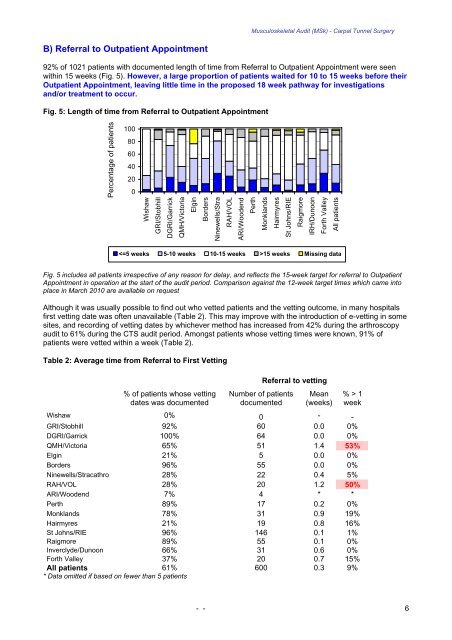
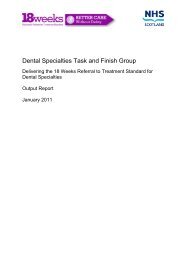
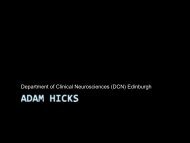
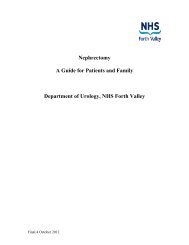
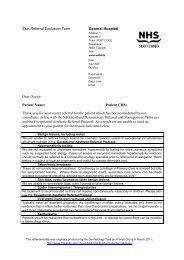
![Dr Matthew Checketts, NHS Tayside [PDF - 6Mb] - 18 Weeks](https://img.yumpu.com/49027155/1/190x143/dr-matthew-checketts-nhs-tayside-pdf-6mb-18-weeks.jpg?quality=85)
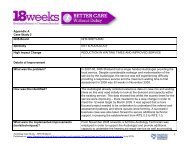

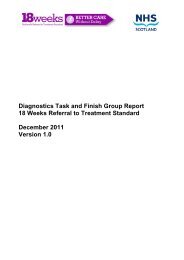

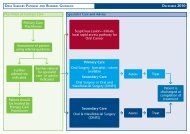

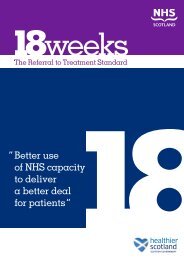
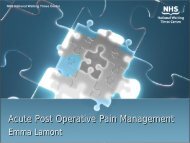
![Mark Sindall, NHS Dumfries and Galloway [PDF - 227Kb] - 18 Weeks](https://img.yumpu.com/30080335/1/190x143/mark-sindall-nhs-dumfries-and-galloway-pdf-227kb-18-weeks.jpg?quality=85)